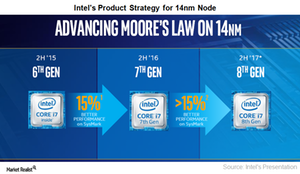Flaws in Intel’s x86 Integration Model
Intel lost the mobile processor market to Qualcomm (QCOM) in 2016. It also lost some PC processor market share to Advanced Micro Devices (AMD) last year.
Nov. 20 2020, Updated 4:42 p.m. ET

Other possible causes for Brian Krzanich’s departure 
The departure of Intel’s (INTC) CEO, Brian Krzanich, for violating the company’s fraternization policy sent shock waves through the industry. After the announcement, analysts looked for other possible causes for such a move. Tech analyst Ben Thompson, in his June 25 Stratechery article, analyzed the possible correlation between the delay in Intel’s 10nm (nanometer) node and Krzanich’s departure.
It’s important to note these factors are the result of Thompson’s analysis of several possibilities and may have no correlation with Krzanich’s departure.
Intel’s x86 integration
Thompson noted that under Krzanich’s leadership, Intel launched the 14nm node in 2014. It’s been leveraging the same node to date, as technical difficulties delayed the 10nm node by almost two years to 2019. This forced Intel to cancel its Knights Hill Xeon Phi processor and instead launch refresher chips on 14nm nodes.
Intel lost the mobile processor market to Qualcomm (QCOM) in 2016. It also lost some PC processor market share to Advanced Micro Devices (AMD) last year. Intel is expected to lose some server processor market share to AMD in late 2018. In his article, Thompson argues that the crux of these issues lies in Intel’s x86 integration model and its insistence on manufacturing its chips.
Intel’s mobile processors
Instead of developing its ARM-based mobile processor, Intel decided to make its x86 chip more efficient. However, high manufacturing costs and power consumption of its x86-based Atom mobile processors forced Intel to exit the mobile processor market with a $4.0 billion loss.
TSMC (TSM) cashed in on this opportunity by manufacturing ARM-based mobile processors for Qualcomm and later for Apple.
Intel’s graphics processors
Even for non-general purpose graphics processors, Intel attempted to build Larrabee architecture on its x86 design. This effort didn’t succeed, and the processors were only suitable for general purpose displays. With this, Intel’s attempt to enter the discrete graphics cards market also was unsuccessful.
This integration model put Intel’s foundry business behind that of TSMC, Samsung, and Global Foundries. We’ll look into this topic in the next article.
Check out all the data we have added to our quote pages. Now you can get a valuation snapshot, earnings and revenue estimates, and historical data as well as dividend info. Take a look!
